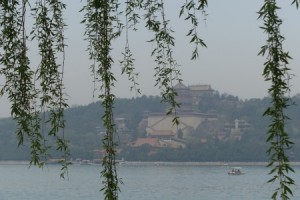
During the 18th century, most people lived a modest and simple life whereas the ruling class lived in opulent accommodations located on magnificent grounds. In China, the Summer Palace is a perfect example of this ostentatious lifestyle. It is located less than 10 miles from central Beijing.
Even though the imperial gardens located in this area were used by Chinese emperors for more than 800 years, the Summer Palace (Yuanmingyuan-Garden of Perfect Brightness) is usually associated with the Qing Dynasty (1644-1911/12). In 1750, during Emperor Qianglong’s reign (1736-1795), an imperial garden and temporary palace for the royal family was built. It was called the Garden of Clear Ripples. In 1860 the Anglo-French forces destroyed these gardens and structures. Twenty-eight years later, under the reign of Emperor Guangxu (1875-1908), the Summer Palace was created. In 1924, the park was open to the public.

After looking at a map, we learned that the grounds cover a total area of more than 300 hectares. Approximately ¾ of the property is covered with water. Two noteworthy features are Longevity Hill and Kunming Lake. It is a World Heritage Site.
As we weaved in and out of tourists groups, I started to admire the mature foliage and stunning architecture. The overall size of the grounds was astounding. During out brief stay, we could only capture a small glimpse of what this retreat has to offer.
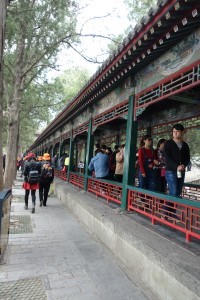
One of the noteworthy features is The Long Corridor (Chang Lang). It starts from Yaoyue (Inviting the Moon) Gate in the east and ends at Shizhang (Stone Old Man) Pavilion in the west. The total length is 728 meters. There are 273 sections. This covered walkway provides protection from the elements as well as a passageway that connects key buildings in the complex.
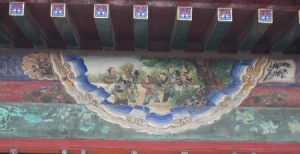
The upper beams showcase more than 8000 paintings of birds, flowers, landscapes, and Chinese classical stories.
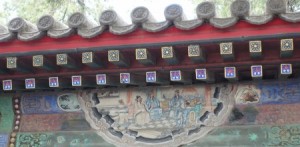
It was hard to keep up with my tour group because I was constantly stopping to look at the amazing artwork and take pictures.
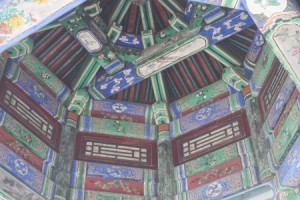
Interspersed at various points are 4 octagonal pavilions. Each has a specific theme associated with the 4 seasons- mesmerizing scenery, harmonizing with the lake, autumn water, and clear and carefree. The pavilion ceilings were brightly painted.
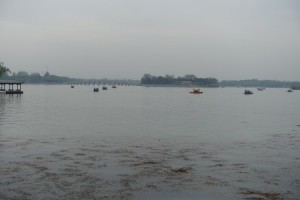
The Long Corridor is strategically placed between the foot of the hill and the lakeshore and links all of the nearby structures. Even though it was a cloudy day, we enjoyed gazing at the lake as we strolled through the corridor.
Between the Pavilion of Harmonizing with Lakes and the Pavilion of Autumn Water, we stopped at the Scenic Area of the Hall of Dispelling Clouds and Tower of Buddhist Incense. This notable and centrally located area covers 20,000 meters. Within its perimeter are a group of palaces, towers, corridors, pavilions, walkways, bridges, archways and inscribed stone steles. Due to our abbreviated stay, we had to continue walking along the Long Corridor and could not climb up the hill. However, we did have a panoramic view of the hill when we took a boat ride.
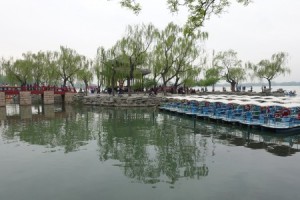
There were multiple docks for paddle boats as well as a couple of docks for small passenger boats.
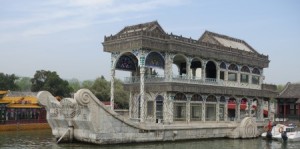
When we reached the end of the corridor, we could see what appeared to be a 19th century American paddle boat. Even though it resembled a boat, it was actually a stone pavilion that was labeled “Marble Boat”. Inside we could see large mirrors that reflected the lake water. Four dragon heads serve as rain water drains. The hull is shaped like paddle wheels. It is the only western-styled structure at the Summer Palace.
Its unusual appearance matches its questionable past. At the end of the 19th century, Empress Cixi and corrupt eunuchs diverted funds designated for a modern Chinese Navy to build this opulent pavilion.
Nearby, we took a short boat ride that provided panoramic views from Kunming Lake.
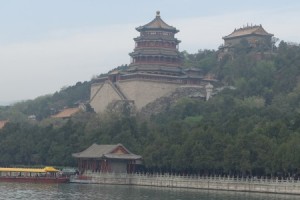
We could look back at the shoreline and see the beauty of the Hall of Dispelling Clouds and the Tower of Buddhist Incense as well as a variety of other buildings that dotted the coastline. These structures from a previous era stood prominently on Longevity Hill.
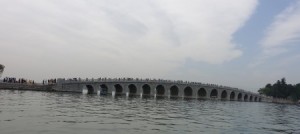
This 17 arch bridge dates back to the time of Emperor Qianlong. It links the eastern edge of Kumming Lake with the the Dragon Ling Temple. In Mandarin Chinese, the number 8 is associated with luck and wealth. The middle arch, number 9, is the largest. According to tradition, the Son of Heaven is set in the middle as a sign of good fortune on both sides.
Personal Reflection of Visit
While researching this historic place, I learned that when the French and British forces brutally attacked the Summer Palace in 1860, they took or destroyed most of the Chinese treasures. The army auctioned off these confiscated items. Today, these pieces of artwork can be found in private and public collections in the UK and France. Some are believed to be in the British Museum.
Until the last few decades, little attention was focused on these spoils of war. During the Cultural Revolution, the Red Guard took measures to forget the past. Now the tide has changed. China has taken a more active role in revitalizing its history. The question remains whether too much time has passed for China to reclaim its lost treasures. Perhaps, a country such as China will have better luck than individuals such as the aging Holocaust survivors and their descendants who struggle to get their stolen heirlooms back.
Related Posts
Sandra’s Bio
Sandra Bornstein is the author of MAY THIS BE THE BEST YEAR OF YOUR LIFE. It is available on Amazon. Sandra’s memoir highlights her living and teaching adventure in Bangalore, India. She is a licensed Colorado teacher who has taught K-12 students in the United States and abroad as well as college level courses. Sandra is married and has four adult sons. The memoir was a finalist in the Travel category for the 2013 Next Generation Indie Book Awards, the 2013 International Book Awards, the 2013 National Indie Book Excellence Awards, the 2013 USA Best Book Awards, and received an Honorable Mention award in the Multicultural Non-Fiction category for the 2013 Global ebook Awards.
Leave a Reply
You must be logged in to post a comment.